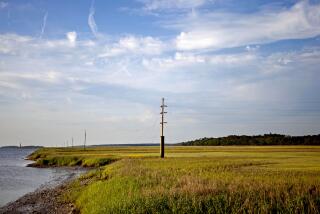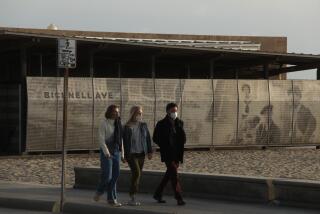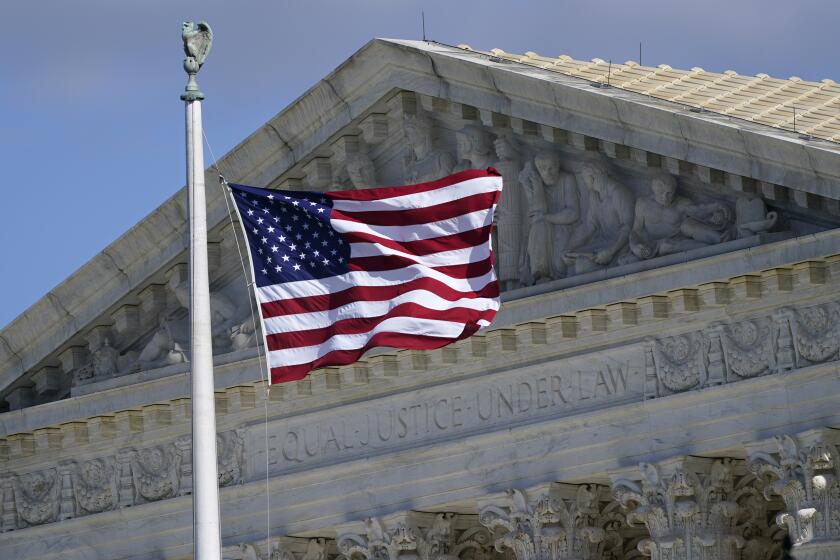Jamaica’s island of isolation
- Share via
Accompong Town, Jamaica — HIGH above the serpentine valleys and vine-tangled trails of this mountainous refuge, runaway slaves could spot approaching bounty hunters and soldiers well in time to ambush all comers.
Along secret paths flanked by steep limestone cliffs, the fiercely independent fugitives guided thousands of fresh escapees from the island’s sugar plantations to safety with horn calls and drum beats familiar to the native Africans.
A natural fortress, this territory was sufficiently remote and forbidding to protect those who fled enslavement and to allow them over the last three centuries to preserve the traditions and tongues of their forebears.
But nearly 500 years after the first slaves were brought to Jamaica, the descendants of the Maroons -- from the Spanish cimarron, or “wild one” -- are discovering chinks in their geographical armor. Outsiders now covet the Maroons’ bountiful minerals, flora and fauna, threatening the long-ignored territory with industrial intrusion and the descendants of slaves with curbs on their independence.
The rugged land called Cockpit Country was ceded to the Maroons after they repelled a decade-long assault by British forces intent on wiping out the runaway slave insurgents. Admitting defeat in 1739, the British signed a treaty granting the Maroons autonomy and control of a little-explored and nearly inaccessible area of limestone towers sheathed in brick-red earth and dense tropical foliage.
For centuries, the Maroons wove vines into clothing, fashioned bowls and other vessels from giant pods that drooped from the green canopy shielding their thatched-twig homes and tilled the rich soil to feed themselves without commerce with British-ruled Jamaicans.
Even since Jamaica won independence from Britain in 1962, the Kingston government has generally honored the reclusive Maroons’ right to self-rule, only recently coming under pressure from foreign mining interests and traders of exotic species to open the territory to the modern world. Some fear the dwindling Maroon population is too weak and scattered to fend off intruders.
About 800 Maroons live in simple wood-and-cinderblock houses dotting the Accompong Town hillsides, down from 1,200 a decade ago and a fraction of the thousands who waged guerrilla war against the British. There is no secondary school, which fuels the exodus, and healthcare is limited to a weekly visit by a nurse from the parish capital of Mandeville, a two-hour drive in the best of conditions.
EXCEPT for the small cultivated plots and modest dwellings, Cockpit Country remains much as it was centuries ago. The forests still provide a bounty of roots, gourds, pods and herbs used in the Maroons’ housewares and natural medicines. Farming and wood carving remain the few subsistence industries in a village served by a single power line that follows the road-cum-trail into the town. There is no postal service, sewers, running water or telephones, although some residents lately have acquired cellphones.
The isolation has protected the pristine environment from the ravages of development elsewhere on the island.
“There’s never been much forestry here because the roads are bad and the trees are so dense you can’t get to them to harvest,” said Mark Wright, 41, a Maroon activist. “The slopes are so steep and everything is so packed together, even hurricanes just blow over us without causing much damage.”
Sydney Peddie -- called “Colonel” by his people though there is no army -- was elected by this town’s Maroons to be their leader. He vows to defend their territory and rekindle the crafts and mores of their ancestors.
“The Maroons are totally against this,” Peddie, 72, said of recent government talk about permitting the mining of bauxite, used to make aluminum.
To ease the economic pressures on a population largely without work, he has urged Maroons to rescue and nurture their language, music and secret drum and horn signals to showcase to tourists exploring the Caribbean’s black history.
“Everybody in Jamaica is a Maroon, but not many realize what the difference is between being a Maroon and being a Jamaican,” said Owen George Francis, a Rastafarian who hopes to reacquaint Maroons with their history. He has embarked on a cultural revival project with his Cockpit Country Heritage Foundation, including educational programs to inform or remind Jamaicans that their background is African, not British.
FRANCIS accuses the Jamaican government of being indifferent to the ecological and historical value of the Maroon region and believes the bauxite prospecting licenses issued by Kingston in 2004 and renewed late last year are the first step toward breaching the British treaty that granted Maroons control of the area.
He has appealed to international defenders of endangered peoples for help in preserving the music and traditions of the Maroons and obtaining United Nations recognition of their independence. He also is lobbying the Jamaican government to reacquaint black Jamaicans with their roots by including in the public school curriculum the nearly extinct Akan language of West African Cormantine tribes from which most Maroons are descended.
Francis, who says he is “head of state” of all Maroons in Jamaica while Peddie represents Accompong Town, contends that bauxite mining is just one of many encroachments threatening Cockpit Country. Rare birds and flowers are sought by collectors, and priceless artifacts from extinct indigenous peoples and early explorers lure historical prospectors.
Maroons need to rediscover their roots, say Francis and Peddie, who otherwise see eye to eye on little.
One anthropological project of Francis’ involves a taciturn Maroon named Chang-ga Chang-ga, who goes about Montego Bay on a bicycle, clothed entirely in dried vines, leaves and bark and posing for camera-carrying tourists. The ancient garb reminds Jamaicans about traditional Maroon dress, which otherwise appears only in historical drawings.
HERE in the surviving heartland of Maroon country, George Hogan, 66, keeps a vanishing art alive. He skins goats and hikes deep into the woods to harvest cedar trees for the gumbe drums he makes using a pattern slaves brought with them from what is now Ghana.
Septuagenarian Hansel Charles Reed is one of the few Maroons still able to communicate the ancient tribal signals with his abeng horn, similar to those used to guide runaway slaves to safety in the 17th and 18th centuries. Its mournful notes herald official events and funerals and are believed to stir up ancestral spirits that bring good fortune to the living and safe passage to the next world for the dead.
Lawrence Rowe, 31, and his girlfriend live with their 4-year-old son in a wood-and-banana-leaf eco-lodge under construction on a promontory overlooking deep ravines and roaring rivers. He is a grandson of Henry Octavius Rowe, the village storyteller and cultural touchstone until his Christmas Eve death at age 103.
“I learned a lot from him about our traditions and folklore,” said Rowe, recalling that another elder told him at his grandfather’s wake, known as Nine Night, that Maroons used to do their own embalming. Remains of forebears are entombed in the territory’s hidden caverns, Rowe said, and trails are being cleared to locate burial grounds and re-create the underground slave escape routes.
Keepers of Jamaican history say the Maroons must document their history before it’s too late.
“They’re too laid-back. They need to do more to preserve their culture or they are at risk of assimilation,” said Hazel Ramsay-McClune, field research officer at the African Caribbean Institute of Jamaica in Kingston. She said she was dismayed to see outside tourist goods among the Maroon crafts for sale at the annual village festival in January -- Bob Marley CDs, T-shirts and tie-dyed clothing.
Some cultural activists insist that Maroon territory extends through most of Jamaica’s interior, including small enclaves scattered across the island. Though only those here and in a handful of smaller settlements identify themselves as Maroon, 91% of Jamaica’s 2.7 million people are black and descended from African slaves, the first of whom were brought in by the Spanish in the early 1500s.
When British forces began driving the Spaniards from Jamaica in 1655, the departing Iberians freed their slaves and encouraged them to take to the hills and resist the new occupiers. Under English rule, 500,000 more slaves were brought to Jamaica for grueling labor on the plantations or to be sold to other slave owners in the West Indies.
Government officials in Kingston paid little heed to the Maroon lands after Jamaica gained independence. But since the foreign mining interests have surfaced, officials contend that they have the right and responsibility to determine the best use of all lands on the island.
“Any land in Jamaica, regardless of who owns it, if it is required for public use the law allows the government to acquire it,” said Donovan Stanberry, permanent secretary for the Ministry of Agriculture and Lands. “That said, it is not the intention of the government to exercise that power in an injudicious way.”
IF the mining companies decide to seek licenses to extract bauxite, the government must conduct an environmental study and hold community hearings to air objections, Stanberry said.
The Maroons speak with one voice in their opposition to bauxite mining, which has left a trail of eyesores and health problems in Jamaican lands to the southeast. The $800-million industry is second only to tourism in economic importance to the island.
“We need to develop more tourism,” said Nicky Hughes, a jobless single mother of four who subsists on what she can earn growing yams and cocoa.
Bill Rowland Peddie, a distant cousin of the town elder, cites prospects other than mining. Natural springs could supply a bottled-water business. Exotic floral and plant species could be developed for sustainable marketing.
It would cost little to create food-processing plants to make plantain chips or canned fruit, he said.
Through such means, said the elder Peddie, “we can survive like our ancestors did, by protecting our ways and refusing enslavement.”
Williams, The Times’ Miami Bureau chief, was recently on assignment in Jamaica.
More to Read
Sign up for Essential California
The most important California stories and recommendations in your inbox every morning.
You may occasionally receive promotional content from the Los Angeles Times.










